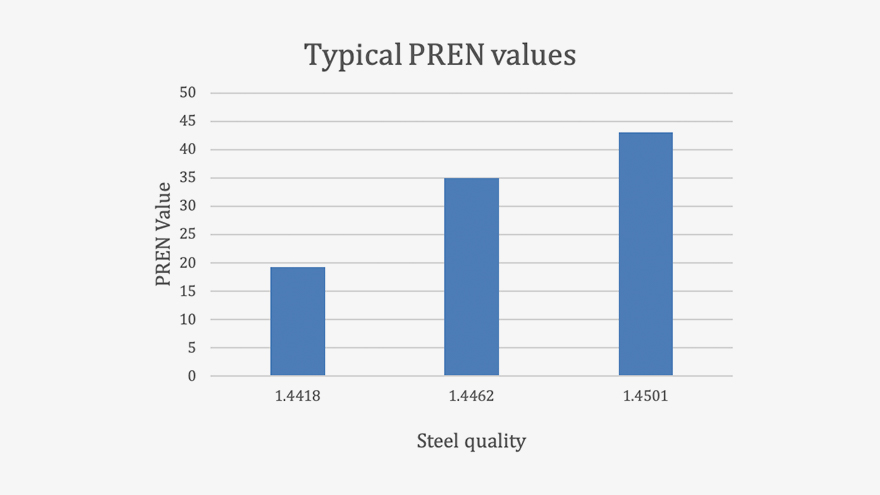For separators made of ordinary grades of stainless steel, the use of lye or acid for cleaning-in-place can make a caustic or acidic combination with milk deposits that is damaging in the long run. For lower total cost of ownership over the equipment’s decades-long life, higher steel grades are a better investment.
Milk is not normally corrosive, but milk deposits can react with cleaning or sterilizing agents to create aggressive liquids that eat away at the surface of ordinary grades of stainless steel. For example, milk contains chlorides that can form deposits during centrifugation. Acids used for cleaning can react with these deposits to form hydrochloric acid at a concentration high enough to corrode certain types of steel.
At first the result is pitting or crevices, but these can eventually turn into cracks. The damage occurs slowly over a number of years, but eventually the bowl becomes irreparable and the whole separator has to be scrapped.
A question of quality
It’s all a question of steel quality, safety and total cost of ownership. Almost all manufacturers of dairy separator bowls use grade 1.4418, a martensitic-austenitic stainless steel stated by one manufacturer – Valbruna – as “for applications in slightly corrosive environments”.
Separators from Tetra Pak, on the other hand, are made with higher grades of steel because of their improved corrosion resistance. They are good enough, in fact, to withstand seawater. The initial investment cost may be higher, but these steels can save dairy customers money in the long run. Which can mean considerable savings over the lift of equipment like separators, which can be operational for as long as 50 years.
Separators from Tetra Pak, on the other hand, are made with higher grades of steel because of their improved corrosion resistance. They are good enough, in fact, to withstand seawater. The initial investment cost may be higher, but these steels can save dairy customers money in the long run. Which can mean considerable savings over the lift of equipment like separators, which can be operational for as long as 50 years.
Two different bowl materials are used, depending on speed. For lower peripheral speed, Duplex steel (1.4462) is used. The steel manufacturer Valbruna describes this as “a stainless acid-resistant Duplex steel with high strength and extremely good corrosion properties”. For the highest bowl speed, an even stronger Super Duplex steel (1.4501) is used with even better corrosion resistance.
Double resistance, double lifetime
PREN (Pitting Resistance Equivalent Number) is a recognized indicator of corrosion resistance for steel. The graph shows average PREN values for the three types of stainless steel mentioned above. As can be seen, the two grades of steel used in Tetra Pak® Separators have about double the PREN value of martensitic stainless steel (1.4418). This equates to a working lifetime in a dairy that is about double that of competitive separators made from the lower grade.

Above: PREN is a measure of corrosion resistance. Many separator manufacturers use steel grade 1.4418 for separator bowls, while Tetra Pak uses 1.4462 and 1.4501.
“Although it could have been tempting to follow our main competitors in their choice of steel, it has never been our philosophy to make a short-term gain while jeopardizing the long-term operation and safety of the separator,” says Åke Ölund, Development Manager for Centrifugal Separation at Tetra Pak. He has specialized in separators since 1983.
“We have always sold dairy separators made of higher grades of steel. Even the oldest dairy separators that I came across at the start had a superior steel quality compared to the competitors,” he recalls. “In all my years, I have never seen a dairy separator from Tetra Pak that has become severely corroded.”
First for second hand
Ölund works with the team at Tetra Pak that is engaged in separator development, market support, training and trouble-shooting. He sometimes gets requests from customers who want spare parts for a separator from Tetra Pak that is more than 45 years old. Some separators were originally installed in Europe or North America and end up being sold second hand to dairies in Africa or Asia where they continue their long life.
“We just don’t know where the separators will end up during their long life,” Ölund says, adding that it is not unusual for our separators to run 24 hours a day for 40 to 50 years, stopping only for service inspections.
A separator originally installed to handle milk may be changed to another application that is more corrosive such as salt whey or salted butter treatment. With a separator from Tetra Pak, the steel is still sufficiently corrosion-resistant. The duplex or super duplex grade has superior durability to meet the demands of all dairy applications. This gives the customer the flexibility to run different products during the lifetime of the separator.
In contrast, switching to a more corrosive product than milk will accelerate the corrosion of a separator made from martensitic stainless steel, shortening its working life and jeopardizing safety.
Åke Ölund points out: “Even with milk or sweet whey, the separator can corrode with time if it is made of a cheap steel. But with our separators, high-quality steel is standard.”

